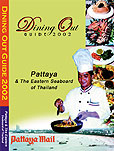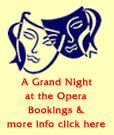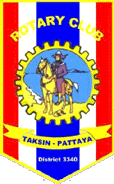- HEADLINES [click on headline to view story]:
-
The Kandy Pageant: Sri Lanka’s Own ‘Son Et Lumiere’ Festival
-
YWCA and Thai Garden Resort treat Charknork Schoolchildren to a fun day
-
S’downers: here, there ... and aware!
|
|
The Kandy Pageant: Sri Lanka’s Own ‘Son Et Lumiere’ Festival
by Peter Cummins
Introduction
The first - and lasting - impression of Sri Lanka is
‘green’. From stepping aboard the Sri Lanka Airlines Airbus, with its
splendid decor, livery and smiling in-flight attendants in their green
saris, to the green expanses of the tea-growing country high up in Nuwara
Wliya, some 2,000 metres above sea-level, Sri Lanka is the ‘nirvana” of
eco-tourism and the Green Peace movements.
Actually, my own visit to Sri Lanka was rather limited,
but no less exotic for being brief. I was urged to go by my Sri Lanka
colleague Dr. Gamini Abeysekera, the personable representative of the United
Nations Children’s Fund (UNICEF) in Thailand - and sponsored by Sri Lanka
Airlines and the Sri Lanka Tourist Board. “My life would not be
complete,” Gamini assured me, “until I had seen, at first-hand, the
Kandy Esela Perahera,” held at the full moon (the Esala) of July/August.
“And take your camera,” he did not really need to counsel me!
 Kandy
Lake and the Dala Maligawa pictured at dusk.
Kandy
Lake and the Dala Maligawa pictured at dusk.
How right he was, for, along with countless thousands of
Sri Lankans, sight-seers, visitors and just plain folks who thronged to
Kandy to see what is mooted as “the grandest torch-lit pageant in Asia”,
I witnessed the overwhelming magnificence of the spectacle. Although many
had already seen the Perahera the previous night, they camped out along the
route, some waiting more than 16 hours for the Grande Finale.
The major difference for the festival this year was the
absence of fighting, bomb threats and assassinations which, understandably,
reduce the enthusiasm of any groups for any festival - anywhere in the
world. The peace accords between the Sri Lanka government and the LTTE (the
Liberation Tigers of Tamil Eelan), ending decades of murderous civil war,
which has been the cause of upwards of 60,000 deaths since July, 1983, had
been brokered by the Norwegian government and will, in fact, be held in
Thailand from 12 - 17 September.
 The
Maligawa Tusker, bearing the Buddha Relics, sets off to the Perehara.
The
Maligawa Tusker, bearing the Buddha Relics, sets off to the Perehara.
Thus, it was a crowd which, feeling safe for the first
time in two decades, filled to over-flowing every available space along the
route. The ‘village green’ in front of the Dalada Maligawa (the sacred
Temple of the Buddha Tooth Relic), lying parallel to the main road along
which the cavalcade was to pass, was a veritable sea of animated, friendly
and smiling humanity.
The Dalada Maligawa, its surrounding temple complex and
other close-by temples and shrines are also the repositories of Sri Lanka
culture, architecture, art, history and, of course, religion. Rare
paintings, frescoes and stone carvings present a marvellous panorama to the
visitor. Religion and culture are inextricably woven into the fabric of Sri
Lanka.
From the very earliest travellers, Sri Lanka was
constantly mentioned as ‘Seyllan” by such chroniclers as John di
Marignoli, a Papal Legate to the court of China in the Fourteenth Century. A
piece of folklore still bandied around is that Adam made a visit to this
“bewitching island” and, somehow, forgot to return to Eden. (There was
not a word about Eve’s thoughts about Adam’s this.)
From “Seyllan’, the island has had a number of
sobriquets, including “Serendib”, a lasting and appropriate name
bestowed by Arab traders who went to the island seeking exotic spices and
the aromatic sandalwood. Serendipity, of course, meaning “the faculty of
making happy and unexpected discoveries by accident” (“Concise Oxford
Dictionary) is most apt for the lovely island.
The Annual Kandy Esala Perahera
Kandy, the “hill capital” is some 130 km east of
Colombo and was so named by the colonial rulers in the nineteenth century.
The British derived the name from the original form of “Kande-uda-rata”,
dropping the suffix and changing ‘Kanda’ in the Sinhala language,
meaning hill, to the easier-to-pronounce anglicised version, Kandy. This
charming city, clustered around the hills and overlooking an artificial
lake, was the capital of the Kandyan Kingdom which succumbed to British rule
in 1815.
The pageant itself lasts for more than a week, with the
climax on the tenth night which corresponds to the full moon. Whip-crackers
lead the way for the two-kilometre long procession, beating the road with
their whips to herald the procession, while torch-bearers, with copra lamps
held high, pour a magic and romantic light onto the spectacle. For 10 days,
the ancient cannon booms at sunset, announcing the imminent start of the
Perahera. Trumpets, conches, oboes and drums beat out a rhythm while a huge
contingent of Kandyan dancers and drummers perform, their stunning period
costumes adding a blaze of colour to the spectacle.
 Crowds
stroll the green in front of the Dala Maligawa.
Crowds
stroll the green in front of the Dala Maligawa.
The moon obliges and shines its magic radiance down on
the scene. Kandyan chieftains clad in traditional attire inter-mingle with
more than 100 magnificently draped tuskers, with brilliantly hued
caparisons, outlined by twinkling lights. The magnificent elephants actually
sway to the drumbeats, as they virtually ‘dance’ along the route of the
procession which takes some five hours to pass.
 The
magnificent facade of the Devala Maligawa - a blaze of lights for the
ceremony. The
magnificent facade of the Devala Maligawa - a blaze of lights for the
ceremony.
The origins of the Kandy Esala Perahera, as it is now
celebrated, date back to the eighteenth century, and since modern times,
include the Maligawa Perihera (the procession of the Temple of the Sacred
Tooth Relic), with the Maligawa Tusker, resplendently adorned, brilliantly
outfitted in an iridescent red caparison, with tiny lights outlining the
huge Tusker’s massive bulk, bearing the casket containing the sacred
relics (not the Sacred Tooth Relic which is enshrined in perpetuity at the
Dalada maligawa) of the Buddha. This ‘super-star’ leads the four
equally-endowed elephants representing Devala, the shrines dedicated to Sri
Lanka’s mythical gods: God Natha, considered the ‘Bodhivista (the next
Buddha), God Vishnu, acknowledged as the guardian deity of Sri Lanka,
Kataragama, the Warrior God and Pattini, the Goddess of Virtue.
The huge crowds are mesmerized by the grandeur, the
colour, the atmosphere and the emotion of the Esala Perahera.
 The
crowds wait patiently along the route of the Perahera.
The
crowds wait patiently along the route of the Perahera.
Curiously, the most pervasive account of the Kandy
Festival is that written by Englishman Robert Knox who was incarcerated by
the then Kandyan King Rajasinghe II, from 1660 - 1679. Knox describes in
detail the order of the procession which, even some three hundred years ago,
was well organized and well rehearsed, with each component in place, while
the King himself rode a horse in the parade. “The Priest bringeth forth a
painted stick ... before which the people bow down and worship, each one
presenting an offering,” wrote Knox. “The Priest then takes the painted
stick on his shoulder and is placed upon an elephant all covered in white
cloth, upon which he rides with all the triumph which the King and the
Kingdom can afford, through all the streets of Kandy.”
Then, as now, heavy responsibility lies on the shoulders
of the Astrologer (the Nekath Mohottala) to divine the exact time of the
commencement of the Perahera activities and rituals.
The “water cutting” ceremony at the Mahaweli River,
which loops around Kandy, is the grand finale of the festivities, which Knox
describes as a symbolic event in honour of the God Indra, when goblets of
water are scooped from the river by the four Devales to be returned to the
temple “where they are kept until the following year and then thrown
away”. The Four Devales then report the successful completion of the
year’s Perahera to the Head of State.
Although, of course, the Kandy Perehera is strictly a
Buddhist celebration, paying annual homage to the Sacred Tooth Relic of the
Buddha, Kandy has a large number of hallowed and vibrant shrines, temples,
churches and mosques, reflecting the multi-religious character of the city -
in fact, of Sri Lanka itself - Buddhist temples, Hindu Kovils, Christian
Churches and Muslim Mosques A just manifestation of a country colonized by
the British, the Dutch and the Portuguese at various times and an ethnic
population comprising Singhalese, Tamil, Moor, Malay and the Burghers
descended from their Dutch and Portuguese forefathers, as well as the
forest-dwelling aboriginal Veddhas - now, 54 years after independence from
Britain, all Sri Lankans.
One cannot but walk away from the Perahera somewhat
chastened by a spectacle which reaches beyond the limited grasp of a merely
human manifestation of pageantry which is indigenous to every culture: the
Perahera embraces - if only for a fleeting moment - the totality of the
universe.
The Elephant
Orphanage
Want to adopt a baby? What about a little cutie weighing
a mere 200 kg? Approximately half way between Colombo and Kandy is the
Pinnawela Elephant Orphanage. Maintained by the Department of National
Zoological Garden, the orphanage was established to feed, nurse and house
baby elephants found abandoned in the forest.
Many of the young ones are found in pits and ravines
where they have fallen - often injured - while foraging for food and water.
Others are the victims of development which has destroyed their natural
environment. This latter calamity sounds familiar to residents of Thailand,
as we daily see these unfortunate ‘gentle giants’ being paraded around
the dirty, polluted streets of Bangkok, forced out of their natural habitats
by ruthless development and brought by their mahouts to ramble the sois and
arteries of the city, competing for space with the motorized traffic.
 Baby
elephants enjoy their daily ‘dip’. Baby
elephants enjoy their daily ‘dip’.
The Pinnawela elephants have a rather better lifestyle,
with the feeding and bathing in the soothing waters of the lower reaches of
the mighty Mahaweli River, Sri Lanka’s biggest and longest waterway. Now,
some 16 years since it was established, the orphanage already has its first
generation of ‘youngsters’ bred at the site.
A visit to the orphanage to see the elephants feeding,
walking (swaying?) down to the river and then enjoying their morning
‘dip’, is just one highlight (one I managed to see, would be more like
the truth), on the road to Kandy. It is possible, as some of the photos
illustrate, to go very close in to the herd, right at the river’s edge.
Visit too brief
My only regret was that there was not more time to see a
little more of “the Tear Drop of the Indian Ocean”: its forests,
magnificent beaches, its mountains, its seven UNESCO-designated National
Heritage Sites (including the spectacular Water Gardens), the impregnable
rock-fortress of Sigiriya, with its fifth century ancient ruins, the
architecture, flora and fauna... Not the least, its smiling, gentle people.
The list is endless. In fact, it is known that, in spite of its relatively
small size (some 65,000 sq. km., compared to Thailand’s 513,000 sq. km.),
Sri Lanka is home to one of the world’s richest bio-diversities: something
Mahatma Ghandi - a man not noted for flowery language (unless he was talking
to his British ‘masters’) - once described “as a scenery sublime,
unsurpassed on the face of the earth.”
 Waiting
for the parade - some sat for 16 hours.
Waiting
for the parade - some sat for 16 hours.
SriLankan Airlines, naturally, promotes the home country
and, now with peace at hand, the enormous potential of tourism is gaining
hold. Working closely with the Sri Lanka Tourist Board, the national carrier
is offering a vast range of holiday and stopover alternatives with its
“Adventure and Exotica” promotional schemes to all destinations.
A great lure is a “Connecting Point Services Scheme”
whereby the hotel costs are absorbed for travellers transiting through Sri
Lanka to other world destinations, for stopovers of between eight to 24
hours in Colombo. This is aimed at “whetting the appetite” of any
traveller passing through, to come back for more. I, for one, shall return
at the first available opportunity, camera at the ready, to explore every
square metre of this undiscovered treasure. When mass tourism discovers the
delights of this island, I shall be happy I was there before it, as I was in
Thailand more than two decades ago.
I look forward to hearing again that traditional warm,
friendly Sri Lanka welcome greeting “Aybowan” - meaning, “may you live
long”. And then I shall have my first cup of Ceylon tea - unquestionably
the world’s best - and I shall certainly live longer as a result of both
the greeting and the tea!
YWCA and Thai Garden Resort treat Charknork Schoolchildren to a fun day
Laor Thongpradap
The president of the YWCA Pattaya Chapter, Ms. Nittaya
Patimasongkroh and Elfi Seitz, representing the Thai Garden Resort, spearheaded
a community contribution of lunch and playground equipment worth 25,000 baht to
the children of Charknork School.
 President
of the YWCA “Lunch Project” Premruedee Jittiwutthikarn presents lunch
funds to Jomthong Inthana, headmaster of the Charknork School. President
of the YWCA “Lunch Project” Premruedee Jittiwutthikarn presents lunch
funds to Jomthong Inthana, headmaster of the Charknork School.
The two benevolent women said they wanted to treat the
children to a fun day out, a nourishing lunch and give them something to play
and exercise with during their free time. “These kids should be healthy and
active,” the organizers said.
 Ms.
Nittaya Patimasongkroh (right) and Ms. Ubonpan Rerksasoot dish out a
scrumptious lunch for the schoolchildren. Ms.
Nittaya Patimasongkroh (right) and Ms. Ubonpan Rerksasoot dish out a
scrumptious lunch for the schoolchildren.
Peeravut Samutthong from World of Language & Computer
also brought down performing self-defense sword shows from Puthaisawan in
Bangkok, which thrilled everyone at the event.
 Charknork
Schoolchildren truly enjoy their new playground equipment. Charknork
Schoolchildren truly enjoy their new playground equipment.
Jomthong Inthana, the director of the Charknork School in
Huay Yai District said his children are good and intelligent, but still need
much more funding to continue their education. Government allocations are not
quite adequate to effectively help all the children.
 The
self-defense sword shows from Puthaisawan, Bangkok, amazed everyone at the
event.
The
self-defense sword shows from Puthaisawan, Bangkok, amazed everyone at the
event.
Jomthong was moved by the kindness and good deeds shown by the YWCA and the
Thai Garden Resort in making the children so happy and putting smiles on their
faces.

Charknork
Schoolchildren enjoy their lunch.
S’downers: here, there ... and aware!
By Peter Cummins
The new executive director of the Australian-Thai Chamber
of Commerce was “sworn in” - so to speak - by Mark Driscoll, AUSCHAM
president at the August Sundowner. Annie Weber follows such capable persons
as Kathy Lindsay and Anita North who have guided the Chamber forward to the
25th anniversary, celebrated at the end of June.
The August Sundowner again saw the Third Floor of the
Australian Embassy packed to capacity, with excellent food provided by
staunch AUSTCHAM supporter - and good neighbour - the Park Suanplu, which,
according to many, “is a luxurious, fully-serviced residence”. However,
the management team, which was out in full force for the evening, prefers to
call their magnificent facilities, “Your home”. You can ‘Park’
there, too, on Sundowner evenings.
 G.M. of
Park Suanplu, Khun Nijaporn introduces his management staff (R), with new
AUSTCHAM Exec. Dir. Annie Weber and Pres. Mark. G.M. of
Park Suanplu, Khun Nijaporn introduces his management staff (R), with new
AUSTCHAM Exec. Dir. Annie Weber and Pres. Mark.
The S’downer’s corporate sponsor was Smith Hodgkinson
(Thailand), a member of the prestigious international network of asset
evaluators, disposal and consultancy services. The company will hold a
unique auction of exquisite Versace fine jewellery and watches, it was
announced, to take place in Singapore on 26, 27 August. Anyone with $US500 -
$US250,000 to spare should proceed to the Island Republic forthwith. No
doubt, many of these ‘one-off’ items will be snapped up very quickly. As
fate would have it, I shall be in Singapore on those days and I shall
certainly be there at the Raffles Town Club - with my Visa (card, that is -
not my Singapore entry visa).
 President
Mark announces the opening of the Ban Khao Din School Library, Rayong on 02
November - and requests support. President
Mark announces the opening of the Ban Khao Din School Library, Rayong on 02
November - and requests support.
The ever-popular Eastern Seaboard Sundowner was held at
the beautiful Garden Beach Resort in mid-July which, following a total
refurbishment more than a year ago, can arguably be regarded as the best
beach resort in Chonburi. Certainly, thanks to the hotel and a very
dedicated residents’ group at Wongamat, the long, crescent-shaped strand
is, by far, the cleanest and best-maintained beach in the Pattaya-Jomtien
area. What a place for a regatta, I thought.
Corporate sponsor was Rod Skinner’s Transit
Maintenance, the Sriracha-based company, also a long-time supporter of the
Seaboard Sundowner.
 H.E. Miles
Kupa mixes it with the Alumni. H.E. Miles
Kupa mixes it with the Alumni.
The next one will be the first of November, as announced
by President Mark at the August function, to precede the official opening of
one of the AUSTCHAM’s Silver Anniversary projects, a new library at the
Ban Khao Din School, Chonburi on Saturday, 02 November. Groundbreaking for
this highly-commendable AUSTCHAM initiative was undertaken by Khun Suttipong,
Khun Kathilda, Gary White, President Mark and Ken Lloyd last June. Mark also
urged contributions towards the excellence of this educational facility for
Thai children.
 Treasurer
Gary White: “Has that photographer paid for the Sundowner?” Treasurer
Gary White: “Has that photographer paid for the Sundowner?”
Another recent event, though not AUSTCHAM sponsored,
nevertheless was attended by a number of members. It was the Second Annual
Australian High School Alumni gathering, this year held at the splendid
Hilton International, together with an Australian school study fair. A big
contingent of Thai alumni from Australian schools as well as many parents,
representatives of the Thai public and private sectors and teachers from
many Australian schools attended.
 “Frequent
‘Sundowner’ Flyers” do a spot of networking. “Frequent
‘Sundowner’ Flyers” do a spot of networking.
H.E. Miles Kupa proudly announced that the intake of Thai
students was at a record level - and still increasing, already having
surpassed the intake of Thai students by both the United States and Great
Britain, gauged over the same period. As I recall, Miles said the magic
number of 10,000, but I am a little hazy on that for two reasons: the red
wine was a constant stream and H.E. spoke in fluent Thai. But, I know that
it is close to the right figure!
 Award
winner (Best SMEs) Bob Coombes selects “Choice Foods” and can also
select beautiful ladies for a photo op.
Award
winner (Best SMEs) Bob Coombes selects “Choice Foods” and can also
select beautiful ladies for a photo op.
 All Thai
graduates - with Aussie accents. All Thai
graduates - with Aussie accents.
To the great relief of the readers of AUSTCHAM news, I shall be absent
for a month or two, so you will not have to see this type of story for a
while!
|
|

|
|
News | Business News | Features | Columns | Letters | Sports | Auto Mania
Kid's Corner | Who’s Who | Travel | Our Community | Dining Out & Entertainment
Social Scene | Classifieds | Community Happenings | Books Music Movies
Club in Pattaya | Sports Round-Up
E-mail: [email protected]
Pattaya Mail Publishing Co., Ltd.
370/7-8 Pattaya Second Road, Pattaya City, Chonburi 20260, Thailand
Tel.66-38 411 240-1, 413 240-1, Fax:66-38 427 596
Copyright © 2002 Pattaya Mail. All rights reserved.
This material may not be published, broadcast, rewritten, or redistributed.
|
|

Now Available

|



 Kandy
Lake and the Dala Maligawa pictured at dusk.
Kandy
Lake and the Dala Maligawa pictured at dusk. The
Maligawa Tusker, bearing the Buddha Relics, sets off to the Perehara.
The
Maligawa Tusker, bearing the Buddha Relics, sets off to the Perehara. Crowds
stroll the green in front of the Dala Maligawa.
Crowds
stroll the green in front of the Dala Maligawa. The
magnificent facade of the Devala Maligawa - a blaze of lights for the
ceremony.
The
magnificent facade of the Devala Maligawa - a blaze of lights for the
ceremony. The
crowds wait patiently along the route of the Perahera.
The
crowds wait patiently along the route of the Perahera. Baby
elephants enjoy their daily ‘dip’.
Baby
elephants enjoy their daily ‘dip’. President
of the YWCA “Lunch Project” Premruedee Jittiwutthikarn presents lunch
funds to Jomthong Inthana, headmaster of the Charknork School.
President
of the YWCA “Lunch Project” Premruedee Jittiwutthikarn presents lunch
funds to Jomthong Inthana, headmaster of the Charknork School. Ms.
Nittaya Patimasongkroh (right) and Ms. Ubonpan Rerksasoot dish out a
scrumptious lunch for the schoolchildren.
Ms.
Nittaya Patimasongkroh (right) and Ms. Ubonpan Rerksasoot dish out a
scrumptious lunch for the schoolchildren. Charknork
Schoolchildren truly enjoy their new playground equipment.
Charknork
Schoolchildren truly enjoy their new playground equipment. The
self-defense sword shows from Puthaisawan, Bangkok, amazed everyone at the
event.
The
self-defense sword shows from Puthaisawan, Bangkok, amazed everyone at the
event.

 G.M. of
Park Suanplu, Khun Nijaporn introduces his management staff (R), with new
AUSTCHAM Exec. Dir. Annie Weber and Pres. Mark.
G.M. of
Park Suanplu, Khun Nijaporn introduces his management staff (R), with new
AUSTCHAM Exec. Dir. Annie Weber and Pres. Mark. President
Mark announces the opening of the Ban Khao Din School Library, Rayong on 02
November - and requests support.
President
Mark announces the opening of the Ban Khao Din School Library, Rayong on 02
November - and requests support. H.E. Miles
Kupa mixes it with the Alumni.
H.E. Miles
Kupa mixes it with the Alumni. Treasurer
Gary White: “Has that photographer paid for the Sundowner?”
Treasurer
Gary White: “Has that photographer paid for the Sundowner?” “Frequent
‘Sundowner’ Flyers” do a spot of networking.
“Frequent
‘Sundowner’ Flyers” do a spot of networking. Award
winner (Best SMEs) Bob Coombes selects “Choice Foods” and can also
select beautiful ladies for a photo op.
Award
winner (Best SMEs) Bob Coombes selects “Choice Foods” and can also
select beautiful ladies for a photo op. All Thai
graduates - with Aussie accents.
All Thai
graduates - with Aussie accents.





